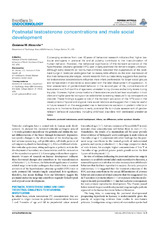| dc.creator | Alexander, Gerianne M. | |
| dc.date.accessioned | 2014-11-21T02:02:36Z | |
| dc.date.available | 2014-11-21T02:02:36Z | |
| dc.date.issued | 2014-01-13 | |
| dc.identifier.citation | Alexander, G. M. (2014). Postnatal Testosterone Concentrations and Male Social Development. Frontiers in Endocrinology, 5, 15. doi:10.3389/fendo.2014.00015 | en |
| dc.identifier.uri | http://dx.doi.org/10.3389/fendo.2014.00015 | |
| dc.identifier.uri | https://hdl.handle.net/1969.1/152289 | |
| dc.description.abstract | Converging evidence from over 40 years of behavioral research indicates that higher testicular androgens in prenatal life and at puberty contribute to the masculinization of human behavior. However, the behavioral significance of the transient activation of the hypothalamic–pituitary–gonadal (HPG) axis in early postnatal life remains largely unknown. Although early research on non-human primates indicated that suppression of the postnatal surge in testicular androgens had no measurable effects on the later expression of the male behavioral phenotype, recent research from our laboratory suggests that postnatal testosterone concentrations influence male infant preferences for larger social groups and temperament characteristics associated with the later development of aggression. In later assessment of gender-linked behavior in the second year of life, concentrations of testosterone at 3–4 months of age were unrelated to toy choices and activity levels during toy play. However, higher concentrations of testosterone predicted less vocalization in toddlers and higher parental ratings on an established screening measure for autism spectrum disorder. These findings suggest a role of the transient activation of the HPG axis in the development of typical and atypical male social relations and suggest that it may be useful in future research on the exaggerated rise in testosterone secretion in preterm infants or exposure to hormone disruptors in early postnatal life to include assessment of gender-relevant behavioral outcomes, including childhood disorders with sex-biased prevalence rates. | en |
| dc.description.sponsorship | The open access fee for this work was funded through the Texas A&M University Open Access to Knowledge (OAK) Fund. | en |
| dc.language.iso | en_US | |
| dc.publisher | Frontiers | |
| dc.rights | Attribution 3.0 United States | en |
| dc.rights.uri | http://creativecommons.org/licenses/by/3.0/us/ | |
| dc.subject | postnatal testosterone | en |
| dc.subject | social development | en |
| dc.subject | infancy | en |
| dc.subject | sex differences | en |
| dc.subject | autism spectrum disorder | en |
| dc.title | Postnatal Testosterone Concentrations and Male Social Development | en |
| dc.type | Article | en |
| local.department | Psychology | en |
| dc.rights.requestable | false | en |



